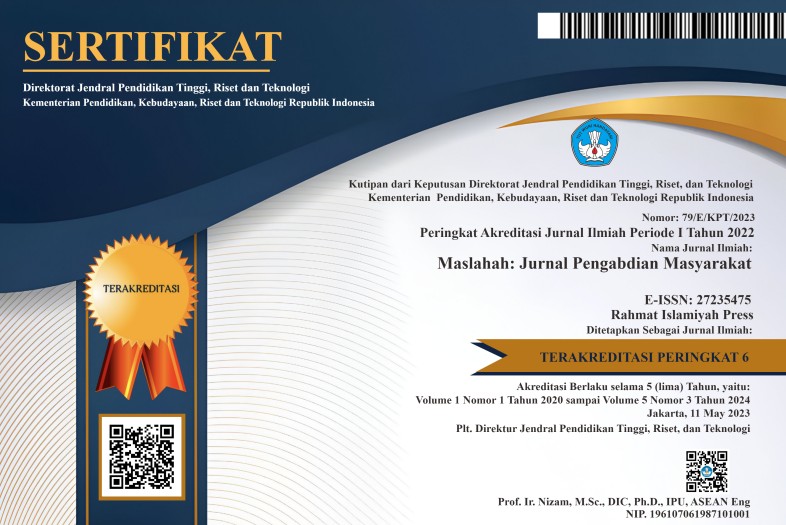Pelatihan Fermentasi Kotoran Kambing Menjadi Pupuk Organik Di Desa Banjaran Raya
Abstract
Chemical fertilizers are the "idol" for fulfilling plant nutrition, while there are forgotten "pearls", namely organic fertilizers which still contain a number of nutrients. One of them is goat dung. Goat dung is relatively easy to obtain and generally many people who live in rural areas keep livestock, either individually or in groups. From our survey to one of the breeders in Banjaran Raya Village and from information obtained through Interview with the farmer, it turned out that the livestock manure was left around the pen after cleaning the pen and they even used it directly on the plants, meaning that the manure had been piled up without being fermented beforehand, they thought that it could be used on the plants, while fresh goat manure was hot because the ammonia content was quite high. . Based on the analysis, goat manure has many benefits, namely increasing water retention so that it does not dry out easily, making the soil looser and having good porosity, drainage and aeration, increasing the soil's chemical holding capacity or higher cation exchange capacity so that when given chemical fertilizer it is not easily leached ( leaching) and are lost with water, increasing the activity of soil microorganisms so that more nutrients are available to plants, which must first be processed before use by fermentation. Based on information from the community, we feel compelled to educate them by conducting training on the fermentation process of goat manure into organic fertilizer or compost that is ready to be used for plant nutrition. Of course, apart from that, we also hope to increase the income of the local community where the compost that is ready to use can be sold, so it is very necessary. educate that livestock manure can still be utilized by plants and through training the Banjaran Village community in terms of the appropriate steps in the fermentation (composting) process so that the results are quality.
Full Text:
PDFReferences
Alakhyar, Fahrurrozi, Widodo, Saria, N. (2019). Use Of Gliricidia- Enriched Liquid Organic Fertlizer For Production Of Caisim (Brassica juncea L.). Jurnal Agroqua : Media Informasi Agronomi dan Budidaya Perairan,17 (1):1-7
Dewi, Y.S., Treesnowati. (2012). Pengolahan sampah skala rumah tangga menggunakan metode composting. Jurnal Ilmiah Fakultas Teknik LIMIT’S. 8(2): 35-48.
Hapsari,A.Y.(2013).Kualitas dan kuantitas kandungan pupuk organik limbah serasah dengan
inokulum kotoran sapi secara semianaerob. skripsi. Fakultas Keguruan dan Ilmu
Pendidikan.Universitas MuhammadiyahSurakarta.
Hardjowigeno, Sarwono. 2003. Ilmu Tanah. PenerbitAkademikaPressindo: Jakarta
Pangaribuan, D., Pujisiswanto, H. (2008). Pemanfaatan kompos jerami untuk meningkatkan produksi dan kualitas buah tomat. Prosiding Seminar Nasional Sains dan Teknologi II 2008, Universitas Lampung, 17-18 November 2008. p. 1-10.
Rastiyanto, E., Sutirman, & Pullaila, A. (2013). Pengaruh Pemberian Pupuk Organik Kotoran Kambing Terhadap Pertumbuhan Dan Hasil Tanaman Kailan.
Siboro, E.S., Surya, E., Herlina, N. (2013). Pembuatan pupuk cair dan biogas dari campuran limbah sayuran.Jurnal Teknik Kimia USU 2(3): 40-43.
Sukamta et al., 2017. Kompos adalah hasil pendekomposian sejumlah bahan organik yang mana selama berlangsungnya proses tersebut harus
Sukamta, S., Abdus Shomad, M., & Wisnujati, A. (2017). Pengelolaan Limbah Ternak Sapi Menjadi Pupuk Organik Komersial di Dusun Kalipucang, Bangunjiwo,Bantul, Yogyakarta. BERDIKARI : Jurnal Inovasi Dan Penerapan Ipteks, 5(1), 1–10.
Yuliananda, S., Utomo, P. P., & Golddin, R. M. (2019). Pemanfaatan Sampah Organik Menjadi Pupuk Kompos Cair Dengan Menggunakan Komposter Sederhana. Jurnal Abdikarya:03(02), 159–165.
DOI: https://doi.org/10.56114/maslahah.v4i3.11246
Refbacks
- There are currently no refbacks.
ISSN 2723-5475 (Online)



